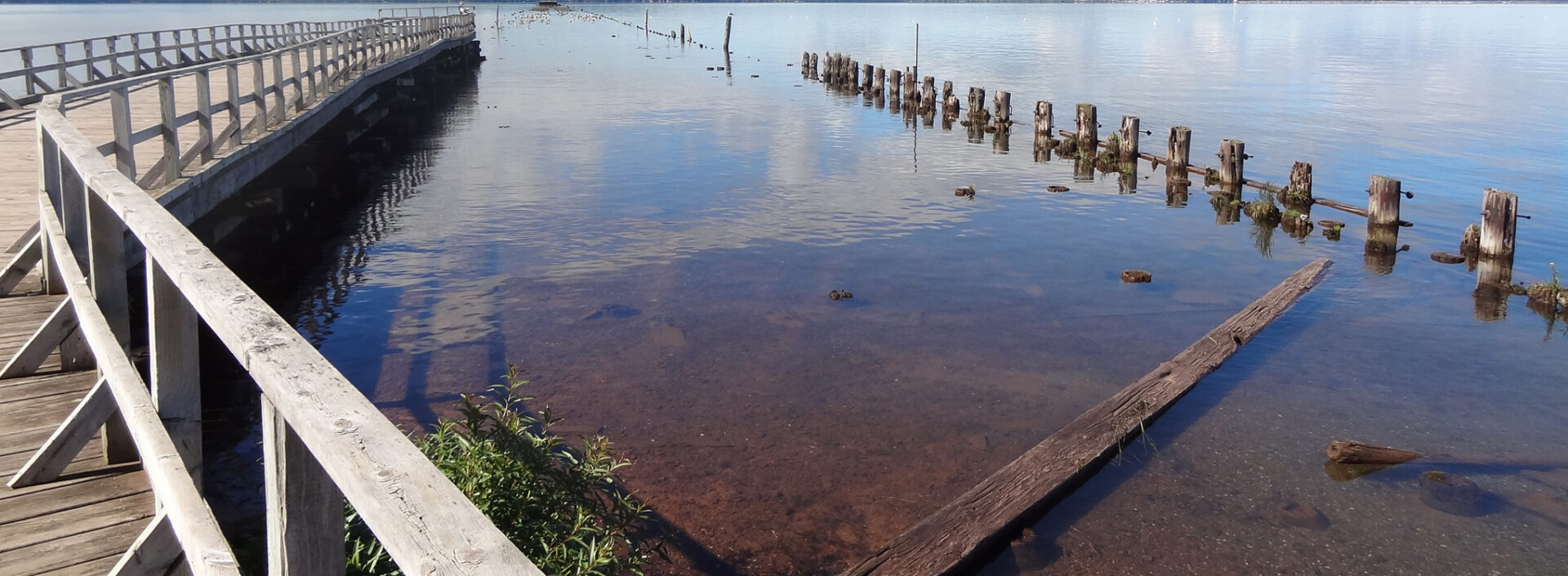Predicted Great Lakes Water Level Responses to Climate Change
Anticipated future lake levels on Superior, Michigan and Huron due to climate change
This information is based on hydrologic model responses to inputs from Canadian and British global circulation models (GCMs) and from a Great Lakes regional circulation model called CHARM: Coupled Hydrosphere-Atmosphere Research Model at the National Oceanic and Atmospheric Administration’s Great Lakes Environmental Research Laboratory (NOAA-GLERL) in Ann Arbor, Michigan.
Hydrologic models at NOAA-GLERL simulate the natural responses of Great Lakes water levels and flows to runoff, precipitation, evaporation, inflows and outflows. The hydrologic models have been run with input from GCMs for the atmosphere under assumed global warming conditions. The regional model; CHARM has been run to project climate over the Great Lakes Basin in time periods centered at 1989, 2030, and 2095. Predicted lake level response results from an improved CHARM run with a hydrologic response model are expected in 2003.
Some preliminary indications
Modeling with the use of early transient GCMs and the Canadian Centre for Climate Modeling and Analysis’ CGCM1 model indicate a possible major lowering of lake levels and a reduction of water supplies to the upper Great Lakes in two or three decades. Present low water levels provide a taste of this possible future.
Water levels predicted from the dryer climate of the CGCM1 model for the upper Great Lakes have greater variability than the variability experienced between 1961 and 1990 which included record high water levels on Lake Superior and both record high and low water levels on Lakes Michigan and Huron.
The CGCM1 model does not include any representation of the Great Lakes nor interactions between the lakes and the atmosphere. The British Hadley Climate Centre’s HadCM2 model does include a crude representation of the Great Lakes but does not include interactions between the lakes and the atmosphere. The CHARM model includes interactions between the Great Lakes and the atmosphere.
Water levels predicted from the wetter climate of the HadCM2 model for the upper Great Lakes do not have greater variability than the variability experienced between 1961 and 1990 and indicate the possibility of higher-than-record water levels in the future.
Climate change is expected to change the shape of the annual water level cycle which has highest water levels in the summer and lowest water levels in the winter.
The following tables show predicted changes from the average lake levels that occurred during a Base Case period of 1961 to 1990. The predicted changes are for 20 year periods centered on the years 2030 and 2090.
Table 1. Predicted Response of Lake Superior to Climate Change (Global Warming).
|
Model |
Year | Change in Water Level | |
| feet | meters | ||
| HadCM2 | 2030 | -0.03 | 0* |
| CGCM1 | 2030 | -0.7 | -0.2 |
| HadCM2 | 2090 | +0.4 | +0.1 |
| CGCM1 | 2090 | -1.4 | -0.4 |
*zeros represent non-zero values less than 0.05 m.
Results obtained by using input from four earlier transient GCMs (GFTR2, HCTR2, MOTR2, and CCTR2) indicated water levels on lakes Huron and Michigan may be lower in 2020 by 1.3, 1.6, 4.6 and 3.0 feet ((0.4, 0.5, 1.4, and 0.9 meters), respectively.
Table 2. Predicted Response of Lakes Michigan and Huron to Climate Change (Global Warming).
| Model | Year | Change in Water Level | ||
| feet | meters | |||
| HadCM2 | 2030 | +0.2 | +0.1 | |
| CGCM1 | 2030 | -2.4 | -0.7 | |
| HadCM2 | 2090 | +1.1 | +0.3 | |
| CGCM1 | 2090 | -4.5 | -1.4 | |
*zeros represent non-zero values less than 0.05 m.
Results obtained by using input from four earlier transient GCMs (GFTR2, HCTR2, MOTR2, and CCTR2) indicated water levels on lakes Huron and Michigan may be lower in 2020 by 1.3, 1.6, 4.6 and 3.0 feet ((0.4, 0.5, 1.4, and 0.9 meters), respectively.
Sources of information for Tables 1 and 2 a) Preparing for a Changing Climate, Great Lakes Overview. Peter J. Sousounis and Jeanne M. Bisanz. October 2000. A report of the Great Lakes Regional Assessment Group for the U.S. Global Change Research Program. AOSS Department, University of Michigan, Ann Arbor, Michigan 48109-2143, b) Supplemental information from Brent M. Lofgren, NOAA Great Lakes Environmental Research Laboratory. March 2002.
More About the Models and How to Use the Information in the Tables
Where to get more information on climate change and information on expected water level changes on the other Great Lakes?
More information on the potential lake level changes for all of the Great Lakes as predicted by hydrologic response models and GCMs will be published in a future issue of the Journal of Great Lakes Research in an article titled: Evaluation of Climate Impacts on Great Lakes Water Resources by Brent M. Lofgren, Frank H. Quinn, Anne H. Clites, and Raymond A. Assel. The paper includes results for a period centered in 2050.
Early results from CHARM modeling will be given in a short paper titled: Simulation of Possible Future Effects of Greenhouse Warming on Great Lakes Water Supply Using a Regional Climate Model that has been submitted by Brent Lofgren to the American Meteorological Society’s 17th Conference on Hydrology.
For new developments in modeling estimated impacts of climate change on Great Lakes water levels, periodically check NOAA-GLERL.
For new developments in research on climate change, check NOAA climate change.



